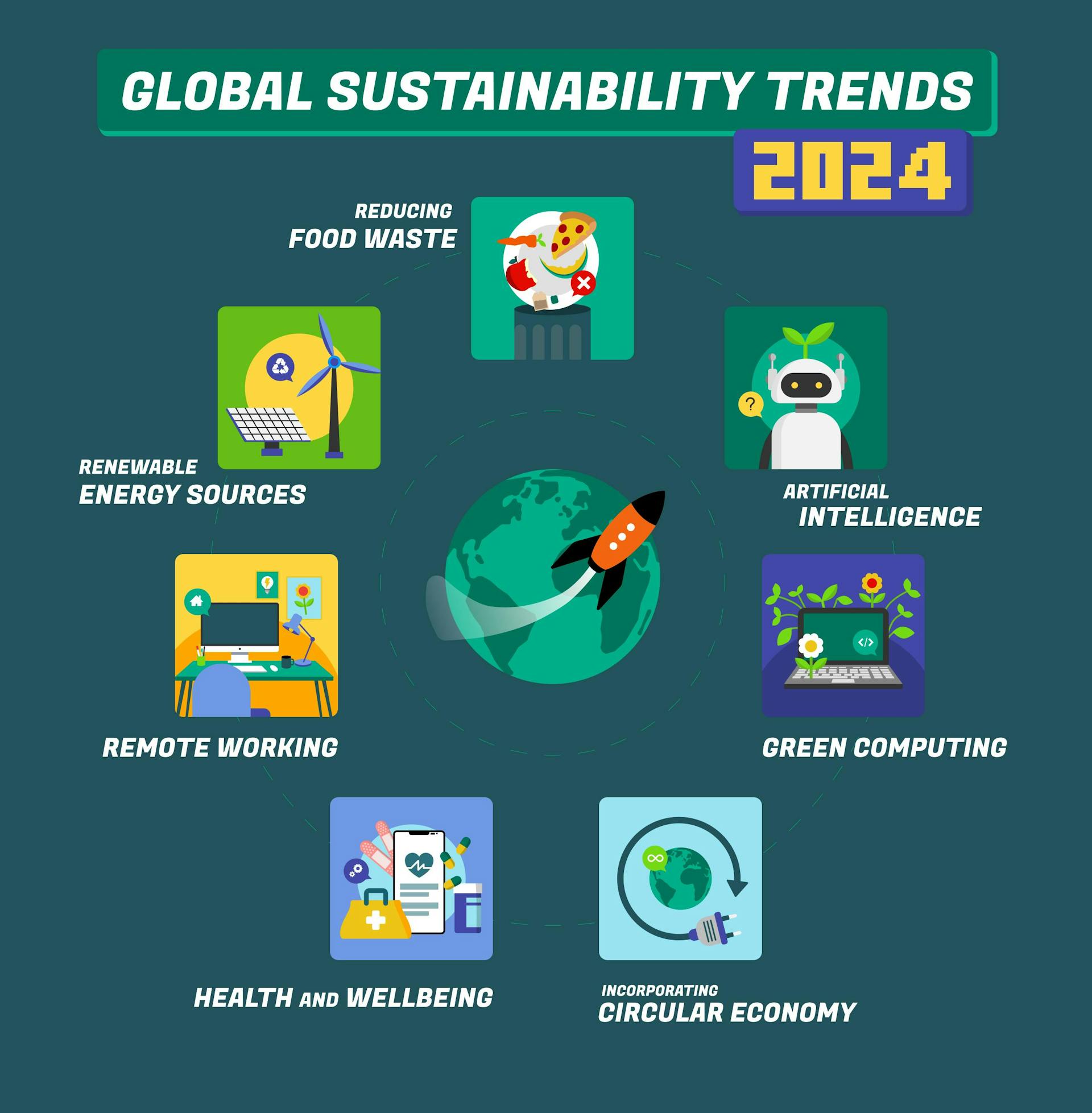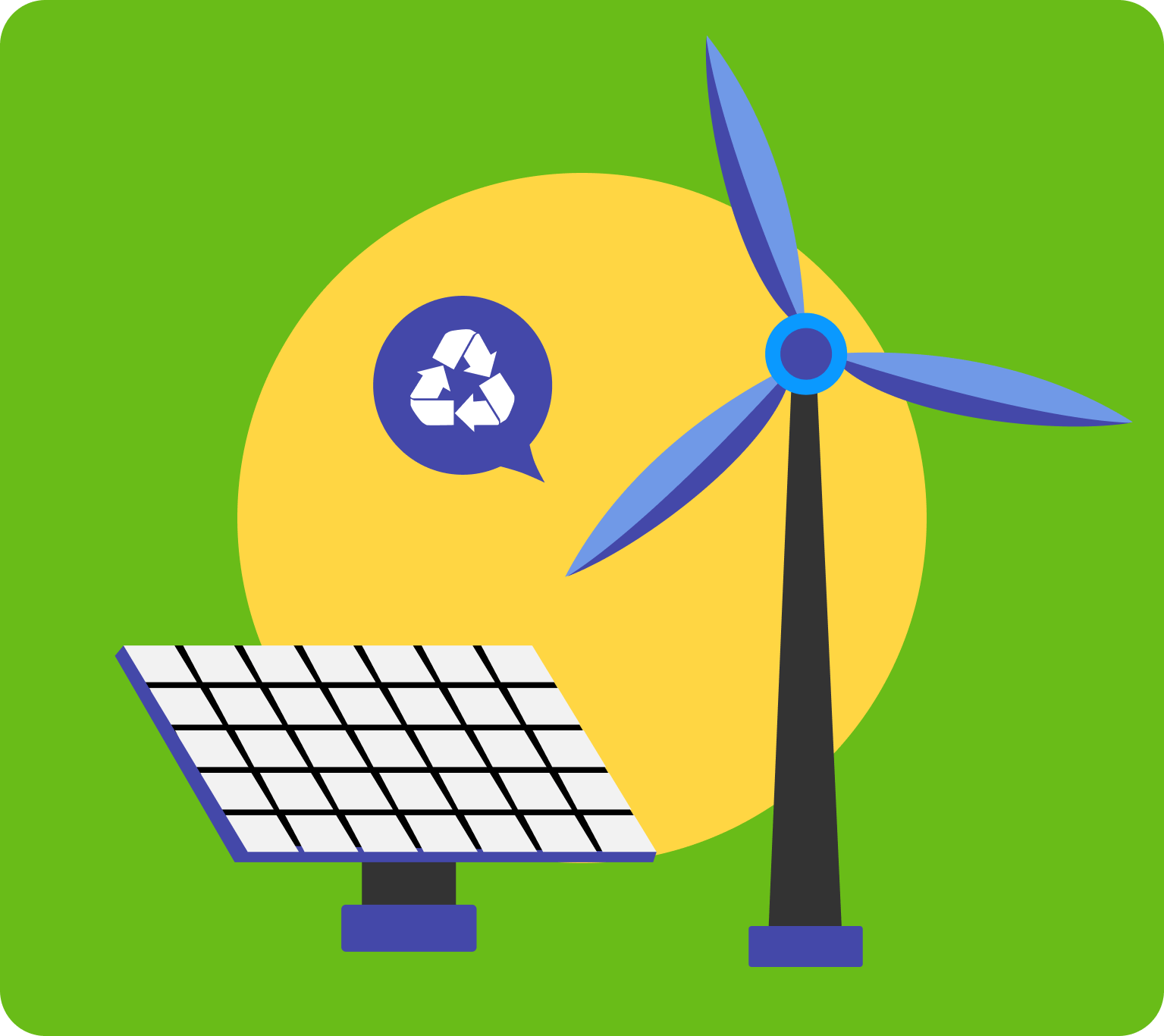Navigating The Future: 7 Key Sustainability Trends In Technology for 2024

As global carbon dioxide emissions hit a record high in 2023, the need for companies to reduce their environmental impact has never been greater.
It's not just about recognising the challenges but also actively seeking solutions, and technology is a key tool for solving many of these issues.
Sustainability is not merely a trend; it's a revolution reshaping how we live, work, and interact with our planet.
For Rocketmakers, this moment presents both a challenge and an extraordinary opportunity for positive environmental and societal change.
In this article, we’ll explore the top sustainability trends in technology for 2024, highlighting how advancements in energy efficiency, renewable energy technologies, sustainable transportation, and more drive a greener, more sustainable future.

Key Trends in Sustainability to Look Out For in 2024

1. Artificial Intelligence (AI)
Increasingly, AI is playing a role in enhancing sustainability across various technology sectors. As we face environmental and resource challenges globally, AI can offer solutions that can be applied in different areas.
This is because AI can analyse large quantities of data to help make informed decisions on energy use, agriculture, urban development, and more.
Below we explore some key areas where AI will make a noticeable impact in 2024:
♻️Supply Chain Management
Increasingly, AI will be used to create sustainable supply chains by increasing efficiency and making them more environmentally friendly. It does this in several ways.
First, AI helps in planning the best delivery routes. By analysing traffic, weather, and schedules, it finds routes that save time, reduce fuel costs, and decrease emissions.
Next, AI is very useful in predicting the demand for products. This helps companies produce and stock just the right amount, avoiding excess production and reducing waste. In managing warehouses, AI systems make sorting and shipping processes quicker and more energy-efficient than traditional methods. The net result of this tech is more sustainable operations.
♻️Environmental Monitoring
In 2024 and beyond, AI will enhance our ability to monitor environmental changes and biodiversity. By analysing large and complex datasets, AI provides insights into the ecological processes essential for biodiversity conservation strategies.
Here are two ways that AI can be used to address various ecological challenges:
Monitoring species
AI algorithms analyse large satellites, sensors, and camera datasets to track species distribution, abundance, and trait changes.
This helps in understanding the dynamics of ecosystems and the impact of human activities on biodiversity. It involves observation, estimation, detection, and attribution to track and predict future changes and identify their causes.
Acoustic monitoring
One innovative method involves using ecoacoustics, which integrates AI with passive acoustic monitoring (PAM) systems.
This approach gathers data on various species' presence, distribution, and behaviour. For instance, Rainforest Connection (RFCx) uses this technology to monitor biodiversity, inform conservation efforts, and track progress towards Global Biodiversity Framework targets.
This method is non-invasive, cost-effective, and scalable, making it a powerful tool for ecological research and supporting environmental conservation efforts.
♻️Energy Efficiency
Another area where AI can have an impact on sustainability strategies is energy efficiency. AI can optimise energy use in data centres, manufacturing processes, and smart grids. By predicting peak load times and adjusting energy consumption accordingly, AI helps reduce overall energy usage and carbon footprint.
Also, AI can enhance the integration of renewable energy sources into the power grid by predicting supply and demand fluctuations, thus making clean energy sources more reliable and efficient.
Energy-saving initiatives not only cut down on energy use and greenhouse gas emissions but also contribute significantly to sustainability efforts.
♻️Eco-Friendly Material Development
AI aids in the research and development of new, more sustainable materials and chemicals, reducing reliance on non-renewable resources and fossil fuels. This includes eco-friendly packaging and the use of alternative materials across various sectors, from fashion to construction.

AI-driven features are not only becoming more understood and reliable but also more widely available, a trend we expect to continue well into 2024. These tools are particularly adept at identifying, understanding, and correcting inefficiencies and negative externalities, making them invaluable in our quest for more sustainable solutions.

2. Green Computing
As a B Corp organisation specialising in creating software products, green computing is something we think about a lot. In 2024, we think more companies will be, too.
One of the main reasons why green computing is increasing in importance is due to the energy cost of generative AI.
Generative AI consumes significant energy due to its reliance on intricate computer models that process and learn from vast data volumes. These models perform numerous calculations to interpret and generate new information, which requires powerful computers.
These computers, running day and night in data centres, use a lot of electricity. So, the more complex the AI tasks, the more energy they need. This is where green computing comes in.
At its core, green computing (also known as green IT or sustainable computing) is the environmentally responsible and eco-friendly use of computers and other computing resources.
It entails adopting practices that lower energy usage and lessen environmental impact, including using energy-efficient hardware, designing sustainable data centres, and recycling electronic waste.
Green computing marks a notable shift in leveraging technology to reduce environmental impact.
Green computing forms part of a broader set of sustainable business practices and includes:
The Shift to Cloud Computing
The migration to cloud computing is a key aspect of green computing. By centralising data storage and processing in highly efficient data centres, cloud computing can reduce the overall energy footprint of IT operations.
There are three major cloud providers: Google Cloud, Microsoft Azure, and Amazon Web Services (AWS). Google Cloud is 1.5x more efficient than a typical data centre and runs on 100% renewable energy.
Microsoft Azure and AWS (despite a less than stellar reputation amongst developers) are not far behind, with commitments to be run by 100% renewable energy by 2025.
Energy-Efficient Software Design
Software design plays a crucial role in green computing. Energy-efficient software runs leaner, requiring less power to operate effectively.
This is particularly important in mobile and web applications where reducing energy usage can significantly impact battery life and overall efficiency.
Developers are increasingly focusing on optimising code for better energy efficiency, a trend that aligns with broader environmental goals.

At Rocketmakers, we design our solutions with a focus on a service ecosystem that prioritises containerisation and scalability. By leveraging scalable technologies, we maintain a cost-optimised model that often proves to be environmentally friendly. We optimise resource usage by scaling down environments and services to zero during idle periods, such as evenings and weekends, and selecting compute resources classified as green for fault-tolerant workloads. From a coding standpoint, we employ technologies like Open Telemetry to meticulously examine code, ensuring it is efficient and lean, thereby reducing the computing resources needed for various functions. These practices exemplify our commitment to creating an environmentally conscious service ecosystem.
Hardware Will Also Go “Green”
This sustainability strategy is not just about creating green software; it also includes hardware:
➡️Recycling and e-waste management: Proper disposal and recycling of electronics to reduce e-waste is a significant aspect of green computing. This includes recycling electronics and safely disposing of hazardous materials.
➡️Energy-efficient hardware: This involves designing and using computing devices that consume less electricity. For example, energy-efficient processors, solid-state drives, and low-power-consuming devices are central to green computing.
➡️Data centre design and operation: Data centres are notoriously bad for the environment. The average data centre uses up to 50 times the energy of a typical office. Green computing practices in data centres involve employing energy-efficient servers, implementing effective cooling systems, and using renewable energy sources.
In addition, to achieve sustainable development goals and decrease IT emissions, the integration of a circular economy model in technology will become increasingly common. We’ll discuss this in more detail below.

3. Incorporating a Circular Economy in Tech Products
The concept of a circular economy is increasingly being adopted in the tech industry, focusing on reducing waste, extending product life cycles, and promoting recycling and reuse. This approach is essential for creating more sustainable technology products and systems.
🔧Modular and Reparable Devices
The trend towards modular and repairable devices is gaining momentum, with companies like Fairphone leading the way. These products are designed for longevity, with easily replaceable parts and upgradable features.
To draw on the example above, some server manufacturers are creating modular server units to eliminate unnecessary waste in data centres.
This means that instead of discarding the entire server when it needs an upgrade, only the main processing unit (the core part that does the computing) can be replaced. This extends the life of the units and cuts carbon emissions associated with the product's manufacturing.
🔧Product-as-a-Service (PaaS)
In the same way, we lease software, leasing hardware will become more common in 2024. Transitioning from selling to leasing products motivates manufacturers to produce durable, maintainable items, as they retain ownership and responsibility for the product's life cycle.
This strategy prompts manufacturers to oversee their products' full lifecycle, including retrieval, recycling, and disposal. These models allow consumers to access the latest technology without continually buying new products, fostering a more sustainable consumption pattern.
🔧Recycling and Upcycling
Innovations in electronic waste management are revolutionising the recycling process. New technologies are emerging for more efficient recycling and material reclamation from old electronic devices, thereby reducing environmental impact and recovering valuable materials.
The implementation of efficient recycling programs to recover valuable materials from old electronics will become more and more important in 2024. Upcycling can also be promoted, where obsolete products are transformed into new, useful items.

4. Health and Wellness Technology
You may be curious about why health and wellness technology is featured in a discussion about sustainability trends. At first glance, prioritising well-being isn't directly related to reducing carbon emissions.
However, its impact is just as significant. Focusing on the well-being of employees and promoting sustainable practices plays a crucial role in nurturing more sustainable business practices and, by extension, a greener economy.
This approach creates a ripple effect: by valuing employee health and encouraging environmentally conscious behaviours, these sustainability initiatives can foster a positive impact that goes far beyond the confines of the workplace. Here's how:
💚Enhancing Employee Well-Being and Productivity
Health and wellness technologies such as fitness trackers, mental health apps, and ergonomic workplace solutions can improve employee health and well-being.
Healthier employees tend to be more productive, take fewer sick days, and contribute more effectively to their organisations, leading to more sustainable business operations.
💚Promoting Healthy and Sustainable Lifestyle Choices
Apps and platforms that encourage physical activity, healthy eating, and mental wellness often promote environmental awareness.
For example, apps that suggest plant-based diets or local food sourcing can contribute to reduced environmental impact.
💚Mental Health and Work-Life Balance
Tools and platforms that support mental health and work-life balance can lead to a more engaged and less stressed workforce. This not only benefits the individual but also promotes a sustainable work environment.

5. Remote Work Will Become Increasingly Common
Remote work, which grew in popularity during the COVID-19 pandemic, is shaping into a lasting trend and is expected to play a significant role in sustainability efforts in 2024.
A key benefit of this shift towards remote work is the significant reduction in daily commutes. With more people working from home, there's a noticeable decrease in traffic and, consequently, a substantial reduction in carbon emissions.
This change is a positive step towards mitigating climate change. Research published in PNAS (Proceedings of the National Academy of Sciences) has shown that remote workers could have a 54% lower carbon footprint compared to onsite workers.
In addition to its environmental benefits, remote work offers greater flexibility, which can significantly improve work-life balance. This flexibility leads to better mental health and lower stress levels amongst employees, enhancing both personal well-being and work productivity.

6. Increased Use of Renewable Energy Sources
Renewable energy technologies are advancing rapidly in the quest to reach net zero emissions, making a big difference in how we generate power. This trend is set to continue in 2024.
At COP 2023, 130 national governments committed to work together to triple the world's installed renewable energy generation capacity to at least 11,000 GW by 2030.
In the world of solar energy, we're seeing significant improvements in the efficiency of solar panels, especially with newer types like perovskite cells. These new cells are not only more efficient in converting sunlight into electricity, but they're also lighter, which could make them easier to use and install.
Wind energy is also seeing some exciting developments, particularly with offshore wind turbines. Engineers are finding better ways to arrange these turbines out in the ocean to catch more wind, which means more power generation and less reliance on non-renewable natural resources.
Then there's the progress in energy storage, primarily with batteries. This is important for renewable energy because it helps store energy when the sun isn't shining or the wind isn't blowing. The latest batteries are improving in how much energy they can hold and how long they can last, making them more reliable and efficient.
Overall, these improvements in solar and wind power and advancements in energy storage are key to moving towards more sustainable and environmentally friendly energy solutions.

7. Reduction in Food Waste
In 2024, reducing food waste is set to be a key sustainability trend. Globally, around one-third of all food produced for human consumption is wasted annually, amounting to about 1.3 billion tonnes.
This waste has far-reaching impacts, from deteriorating soil and water quality to increasing landfill needs. Experts predict a rise in composting practices as a sustainable solution, given that around 72% of landfill waste could be composted.
In the U.S., states like Oregon and Washington are already mandating composting for businesses. This directive addresses the critical issue of food waste, pushing for environmentally responsible practices in businesses and households.
Other ways to tackle this issue include improving supply chain processes, enhancing food storage techniques, and increasing public awareness about food waste. Innovations in packaging to extend shelf life and apps for sharing surplus food are also key strategies.
🚀 Rocketmakers Case Study
💚We’re excited to have contributed to solving the problem of food waste. We partnered with Food Drop to create a smartphone app that shows users where they can pick up surplus food from local cafes. Users can then deliver this food to nearby charities.
This way, the app connects excess food from cafes with those in need, reducing food waste and supporting community welfare.
Final Thoughts
As we have explored in this article, the sustainability trends in technology for 2024 are not just reshaping industries; they are redefining how we approach our relationship with the environment.
Each trend, from AI to the green computing revolution, the adoption of a circular economy in tech products, and advancements in renewable energy technologies, highlights a major step towards a more sustainable future.
The role of technology and software development in driving these sustainable practices cannot be overstated. They are the tools that can transform vision into reality, making sustainable solutions feasible and effective.
For companies, these trends present opportunities not only for growth but also for making positive global contributions. At Rocketmakers, we are excited to be part of this journey.
Our B Corp status is not just a badge; it reflects our dedication to social and environmental responsibility.
Connect with Us!
We invite businesses and entrepreneurs who share our passion for sustainability to explore partnership opportunities with Rocketmakers.
Our commitment goes beyond creating green technology solutions; we aim to drive impactful, sustainable change across industries. Let's work together to make a difference! Get in touch today.



